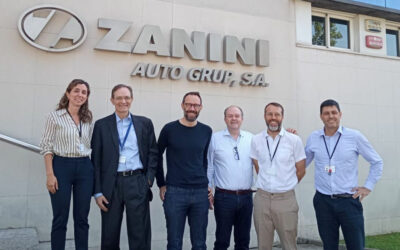Rearview mirrors play a crucial role in road traffic safety. Understanding how they work is both fascinating and illustrative.
For every driver, as it helps to enhance situational awareness and reduces the risk of accidents.
First put in cars in the 1930s, the rearview mirror greatly aided road safety by allowing drivers to see traffic and objects behind them, so they can make informed decisions about turns, lane changes, and other maneuvers without having to turn around and take their eyes off the road ahead.
Although reversing cameras and parking aids can provide an overview of the rear of the vehicle, they do not completely replace the rearview mirror’s real-time and continuous image of the traffic behind. The interior rearview mirror remains an essential part of driving, providing direct visual information which electronic systems cannot completely replace.
One of the key benefits of a rearview mirror is situational awareness. It provides a wider field of view compared to turning one’s head—so without requiring the driver to take their main focus off the road ahead, or to shift their arms and shoulders out of optimal control position. That’s several major safety improvements right there.
Another crucial purpose of the rearview mirror is to assist in parking and reversing. By using the mirror, a driver can accurately judge the distance between their vehicle and objects behind, ensuring a smooth and safe parking or reversing maneuver.
Constituent parts

The reflective surface is typically made of glass, carefully shaped to minimize distortion and provide an accurate representation of the area behind the vehicle. The glass is usually not an ordinary pane with parallel faces. Instead, it is a wedge shape, as shown in the illustration here; the dotted blue line represents the front face, while the rear face is the solid grey line. As in most general-purpose mirrors, the shiny reflective material is applied to the rear face.
When the mirror is in the “Day” position, the driver sees the reflective surface (red arrow in the diagram). Shifting the mirror to the “Night” position swings the reflective surface upward, so the driver’s eyes are no longer in position to see it. Instead, the driver sees reflections off the unreflectorized front face of the glass (green arrow in the diagram). They are much dimmer, which cuts headlight glare from vehicles behind.
The first automatic day/night mirrors shifted the mirror with an electric solenoid to the “Night” position when a certain amount of light hit a rearward-facing light sensor. These gave way to electrochromic mirrors, which use liquid crystal or another technology to variably dim the reflection, still in response to an inbuilt light sensor. Either way, usually the reflective surface is flat, though some mirrors use a convex or aspheric shape to embiggen the field of view. This can reduce or eliminate blind spots, but at the same time it minifies reflected objects—they appear smaller and further away than they really are.
A housing or frame holds the glass in place. This housing can be made of a sustainable material, with a mount which allows the mirror to be positioned according to the driver’s preference; it is a single or double swivel joint, often a ball-and-socket mechanism, which also permits the mirror to break away safely in the event an occupant’s head should hit it during a crash.
Emerging Technologies
Rearview mirrors have come a long way since their inception, and advancements in technology continue to improve their functionality and safety features. Innovations include:
- Digital mirrors, which replace the traditional reflective surface with an LCD or OLED screen to display a live video feed from a rear-facing camera mounted on the back of the vehicle. By eliminating the obstruction caused by passengers, cargo, or vehicle structures, digital rearview mirrors provide an unobstructed and wider view of the rear. It’s much more of a 1:1 replacement than camera-based replacement for sideview mirrors, which pose challenges of how and where to display the images.
- Integrated camera systems use multiple cameras on the exterior of the vehicle to provide an all-round view of the surroundings. The images from these cameras are stitched and displayed on the rearview mirror or the infotainment screen to assist with parking and maneuvering.

- Driver monitoring cameras, as built by the likes of Magna and Gentex
- Antiglare coatings to reduce dazzle caused by strong light sources, such as headlamps or sunlight. These coatings redirect and diffuse the reflected light, improving visibility and creating a clearer reflection of the objects behind the vehicle.
- Lane departure warning systems, which use sensors to detect lane markings on the road. If the vehicle begins to drift out of its lane without signaling, the mirror may provide visual or audible alerts to warn the driver and encourage them to correct their course.
- Augmented reality (AR) technology is being introduced, enhancing the driver’s perception of the rear environment. AR mirrors overlay additional information onto the mirror display, such as navigation cues, object detection warnings, and the speed of trailing vehicles. This provides real-time information and improves situational awareness without distracting the driver’s attention from the road.
- Gesture and voice control are being integrated into rearview mirrors to optimize the HMI. Drivers can adjust the mirror settings, activate camera systems, or access other functions using simple gestures or voice commands. These intuitive controls promote safe and seamless operation of the mirror without the need to take hands off the steering wheel or eyes off the road.
These new technologies are the result of ongoing efforts to make driving safer and more convenient.
Rearview mirrors were mechanical devices for many years, then electromechanical, and now are becoming electronic and software-driven.
Suppliers
SMR Automotive
Prominent rearview mirror suppliers offer a range of products with advanced features. Here are a few examples:

Part of the Motherson Group, SMR develops and manufactures rearview mirror systems and intelligent camera technologies for the automotive industry. They offer interior and exterior mirrors with features like integrated turn signals and blind spot detection.
Gentex

Known for their auto-dimming mirrors, Gentex has been adding features like digital video recorders, multi-view trailer cameras, touchscreen ‘full display’ panoramic digital mirrors, and more. They also integrate features like HomeLink garage door openers, compass displays, and reversing camera displays.
Magna

Magna provides a variety of mirror systems, including with auto-dimming and integrated camera systems. Their ClearView technology provides an unobstructed rearward view from cameras integrated into the exterior of the vehicle, and allows drivers to customize the display—including the ability to zoom, pan, and tilt. An optional additional camera can also add a trailer view. ClearView+ adds driver and occupant monitoring and drunk-driver detection; it won a 2024 PACE Award.
Ficosa

Ficosa, founded in 1949 and headquartered in Barcelona, Spain, offers a range of rearview mirrors with features like automatic dimming, integrated cameras, and blind spot detection.
Murakami

Murakami specializes in safety visibility systems, including high-quality rearview mirrors with advanced features such as automatic dimming. They supply to major automakers.
Outlook
Rearview mirrors have long contained map/reading lights, and new lighting features will likely come along, too. Mirrors are also incorporating electronic displays to show information such as temperature, compass direction, or even incoming calls or messages from a connected smartphone.
Because of substantial opportunities for progress in ADAS, rearview mirrors are now an inevitable part of interior solutions, surround-view systems, and autopark features integrated with autonomous vehicles.
The subjective psychological feel of this evolutionary process is what Canadian philosopher Marshall McLuhan (1911-1980) described in terms of a rearview mirror effect: “We see the world through a rearview mirror. We march backwards into the future”.






